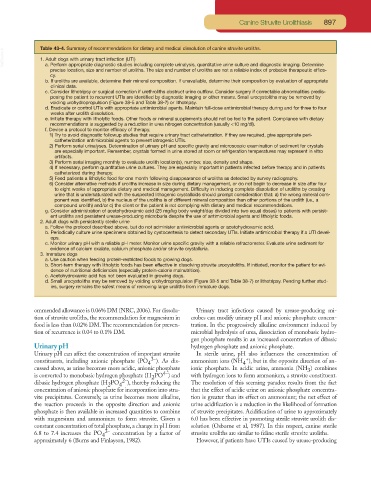Page 866 - Small Animal Clinical Nutrition 5th Edition
P. 866
Canine Struvite Urolithiasis 897
VetBooks.ir Table 43-4. Summary of recommendations for dietary and medical dissolution of canine struvite uroliths.
1. Adult dogs with urinary tract infection (UTI)
a. Perform appropriate diagnostic studies including complete urinalysis, quantitative urine culture and diagnostic imaging. Determine
precise location, size and number of uroliths. The size and number of uroliths are not a reliable index of probable therapeutic effica-
cy.
b. If uroliths are available, determine their mineral composition. If unavailable, determine their composition by evaluation of appropriate
clinical data.
c. Consider lithotripsy or surgical correction if urethroliths obstruct urine outflow. Consider surgery if correctable abnormalities predis-
posing the patient to recurrent UTIs are identified by diagnostic imaging or other means. Small urocystoliths may be removed by
voiding urohydropropulsion (Figure 38-5 and Table 38-7) or lithotripsy.
d. Eradicate or control UTIs with appropriate antimicrobial agents. Maintain full-dose antimicrobial therapy during and for three to four
weeks after urolith dissolution.
e. Initiate therapy with litholytic foods. Other foods or mineral supplements should not be fed to the patient. Compliance with dietary
recommendations is suggested by a reduction in urea nitrogen concentration (usually <10 mg/dl).
f. Devise a protocol to monitor efficacy of therapy.
1) Try to avoid diagnostic followup studies that require urinary tract catheterization. If they are required, give appropriate peri-
catheterization antimicrobial agents to prevent iatrogenic UTIs.
2) Perform serial urinalyses. Determination of urinary pH and specific gravity and microscopic examination of sediment for crystals
are especially important. Remember, crystals formed in urine stored at room or refrigeration temperatures may represent in vitro
artifacts.
3) Perform serial imaging monthly to evaluate urolith location(s), number, size, density and shape.
4) If necessary, perform quantitative urine cultures. They are especially important in patients infected before therapy and in patients
catheterized during therapy.
5) Feed patients a litholytic food for one month following disappearance of uroliths as detected by survey radiography.
6) Consider alternative methods if uroliths increase in size during dietary management, or do not begin to decrease in size after four
to eight weeks of appropriate dietary and medical management. Difficulty in inducing complete dissolution of uroliths by creating
urine that is undersaturated with the suspected lithogenic crystalloids should prompt consideration that: a) the wrong mineral com-
ponent was identified, b) the nucleus of the uroliths is of different mineral composition than other portions of the urolith (i.e., a
compound urolith) and/or c) the client or the patient is not complying with dietary and medical recommendations.
g. Consider administration of acetohydroxamic acid (25 mg/kg body weight/day divided into two equal doses) to patients with persist-
ent uroliths and persistent urease-producing microburia despite the use of antimicrobial agents and litholytic foods.
2. Adult dogs with persistently sterile urine
a. Follow the protocol described above, but do not administer antimicrobial agents or acetohydroxamic acid.
b. Periodically culture urine specimens obtained by cystocentesis to detect secondary UTIs. Initiate antimicrobial therapy if a UTI devel-
ops.
c. Monitor urinary pH with a reliable pH meter. Monitor urine specific gravity with a reliable refractometer. Evaluate urine sediment for
evidence of calcium oxalate, calcium phosphate and/or struvite crystalluria.
3. Immature dogs
a. Use caution when feeding protein-restricted foods to growing dogs.
b. Short-term therapy with litholytic foods has been effective in dissolving struvite urocystoliths. If initiated, monitor the patient for evi-
dence of nutritional deficiencies (especially protein-calorie malnutrition).
c. Acetohydroxamic acid has not been evaluated in growing dogs.
d. Small urocystoliths may be removed by voiding urohydropropulsion (Figure 38-5 and Table 38-7) or lithotripsy. Pending further stud-
ies, surgery remains the safest means of removing large uroliths from immature dogs.
ommended allowance is 0.06% DM (NRC, 2006). For dissolu- Urinary tract infections caused by urease-producing mi-
tion of struvite uroliths, the recommendation for magnesium in crobes can modify urinary pH and anionic phosphate concen-
food is less than 0.02% DM.The recommendation for preven- tration. In the progressively alkaline environment induced by
tion of recurrence is 0.04 to 0.1% DM. microbial hydrolysis of urea, dissociation of monobasic hydro-
gen phosphate results in an increased concentration of dibasic
Urinary pH hydrogen phosphate and anionic phosphate.
Urinary pH can affect the concentration of important struvite In sterile urine, pH also influences the concentration of
+
constituents, including anionic phosphate (PO 4 3- ). As dis- ammonium ions (NH ), but in the opposite direction of an-
4
cussed above, as urine becomes more acidic, anionic phosphate ionic phosphate. In acidic urine, ammonia (NH ) combines
3
4-
is converted to monobasic hydrogen phosphate (H PO ) and with hydrogen ions to form ammonium, a struvite constituent.
2
dibasic hydrogen phosphate (H PO 4 2- ), thereby reducing the The resolution of this seeming paradox results from the fact
2
concentration of anionic phosphate for incorporation into stru- that the effect of acidic urine on anionic phosphate concentra-
vite precipitates. Conversely, as urine becomes more alkaline, tion is greater than its effect on ammonium; the net effect of
the reaction proceeds in the opposite direction and anionic urine acidification is a reduction in the likelihood of formation
phosphate is then available in increased quantities to combine of struvite precipitates. Acidification of urine to approximately
with magnesium and ammonium to form struvite. Given a 6.0 has been effective in promoting sterile struvite urolith dis-
constant concentration of total phosphate, a change in pH from solution (Osborne et al, 1987). In this respect, canine sterile
6.8 to 7.4 increases the PO 4 3- concentration by a factor of struvite uroliths are similar to feline sterile struvite uroliths.
approximately 6 (Burns and Finlayson, 1982). However, if patients have UTIs caused by urease-producing

